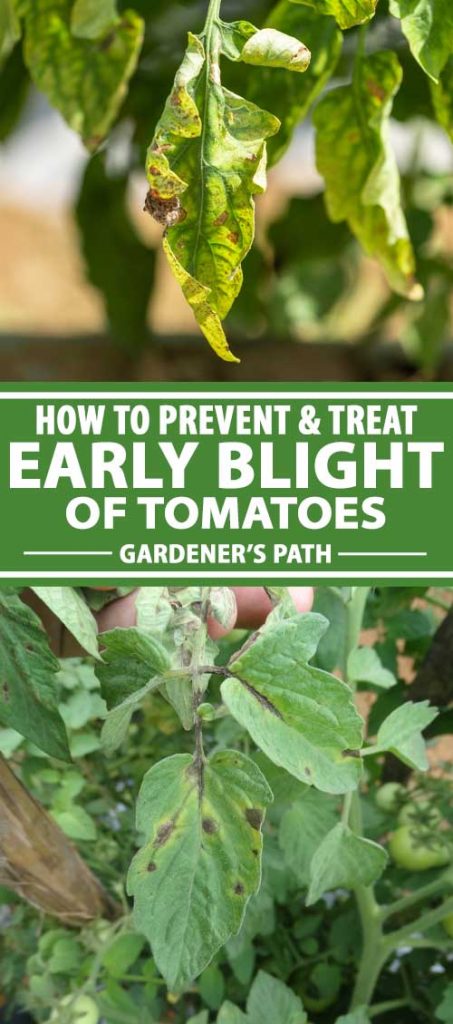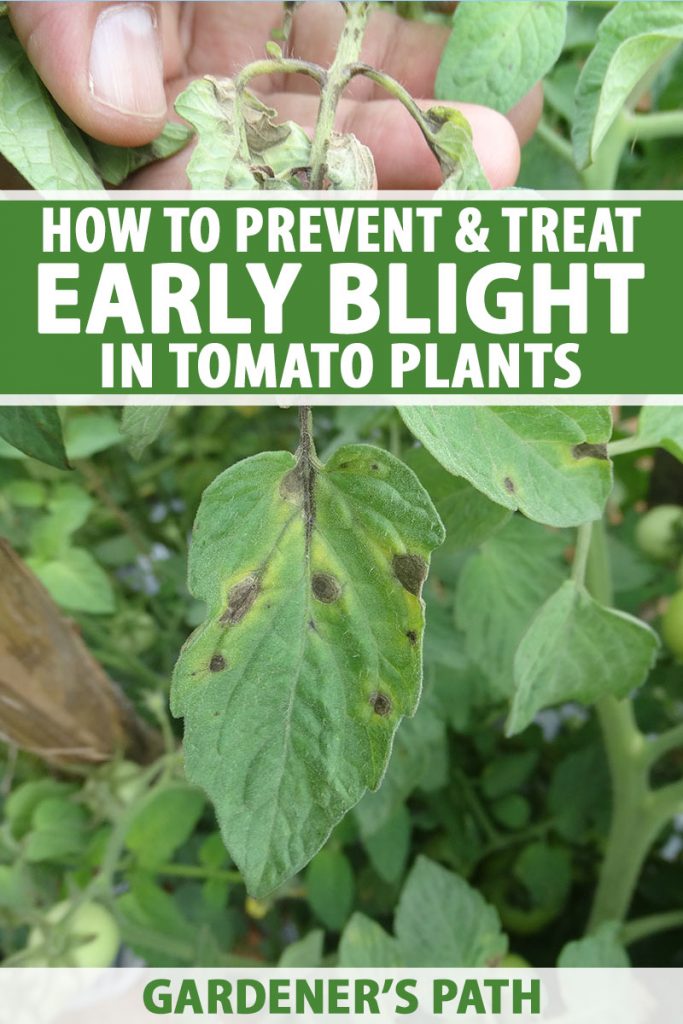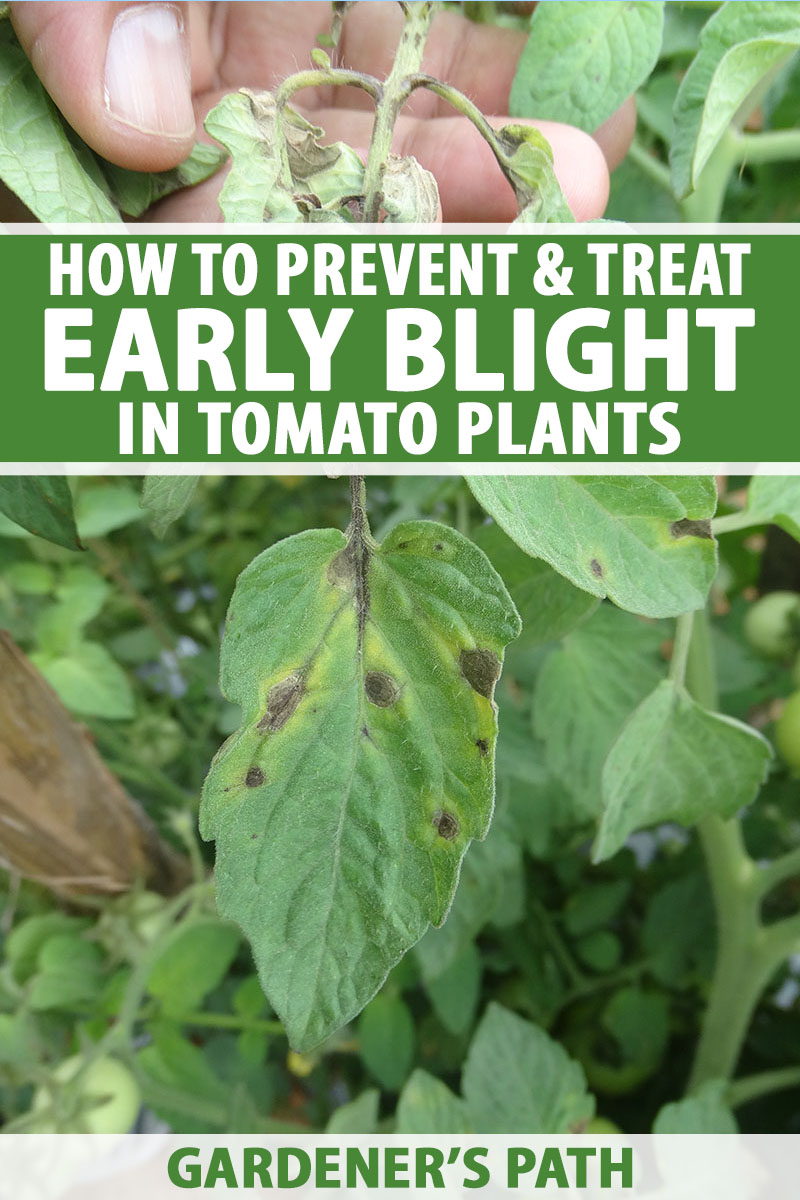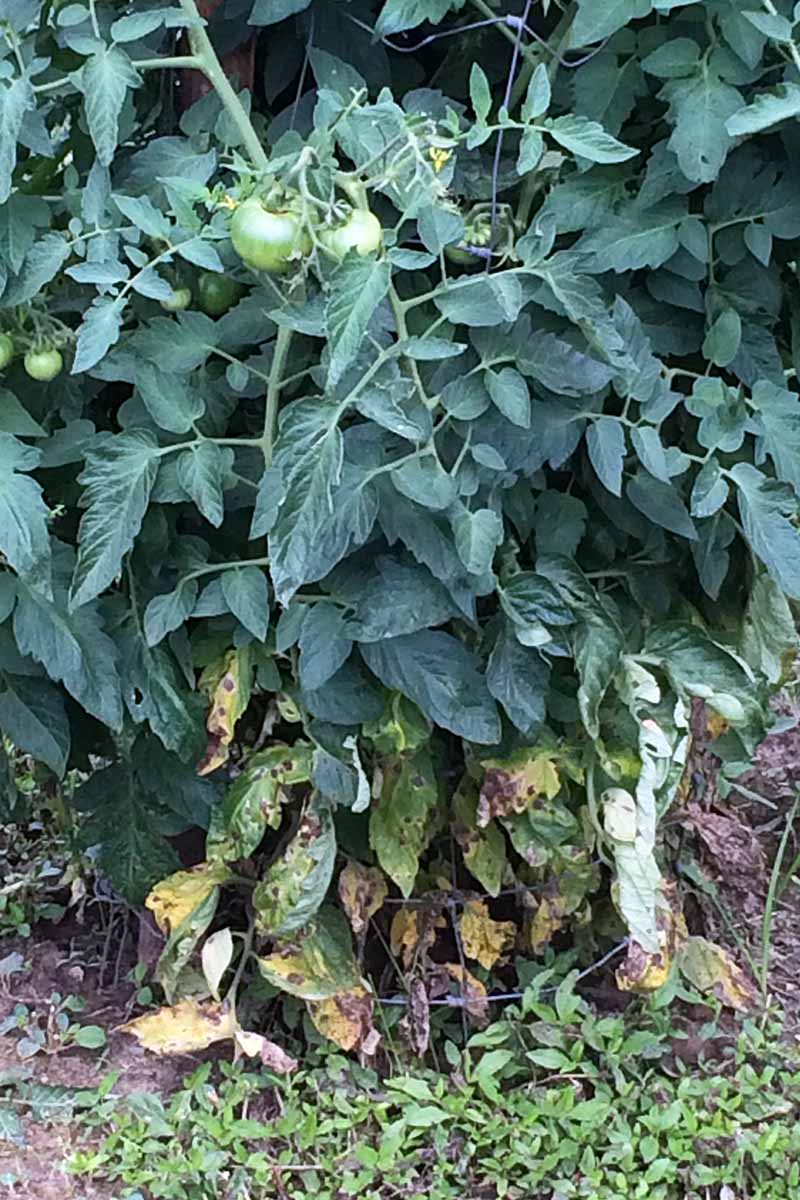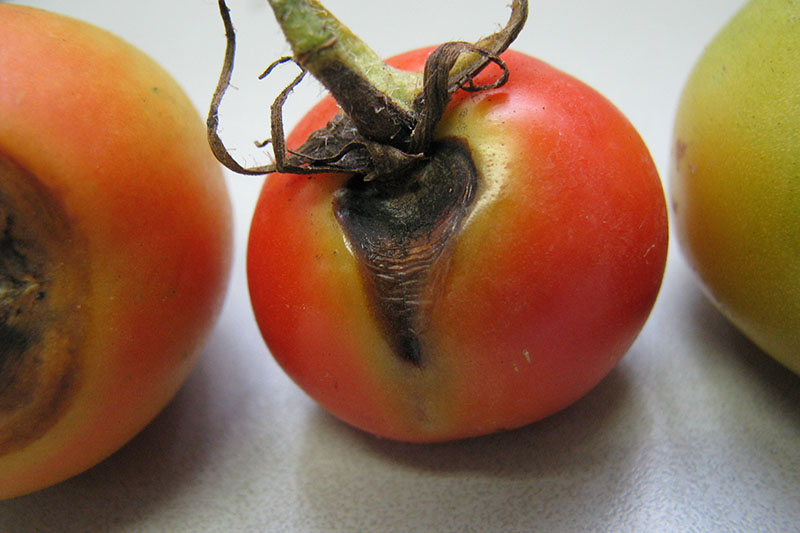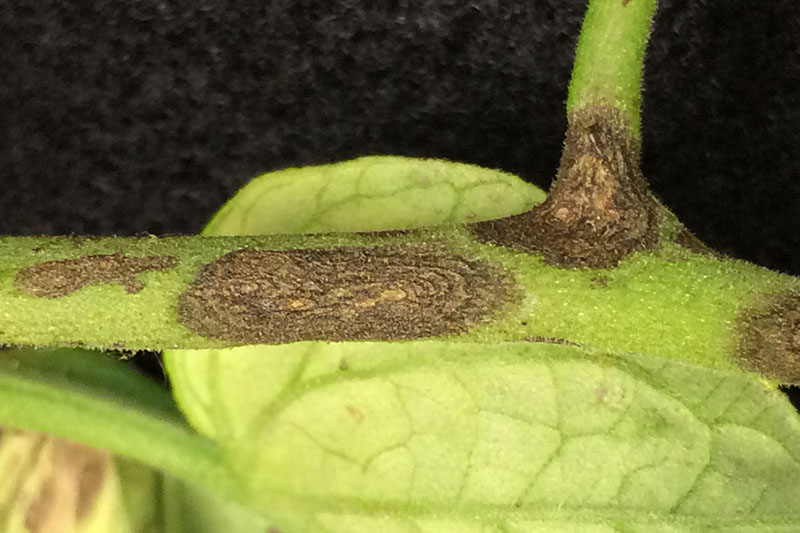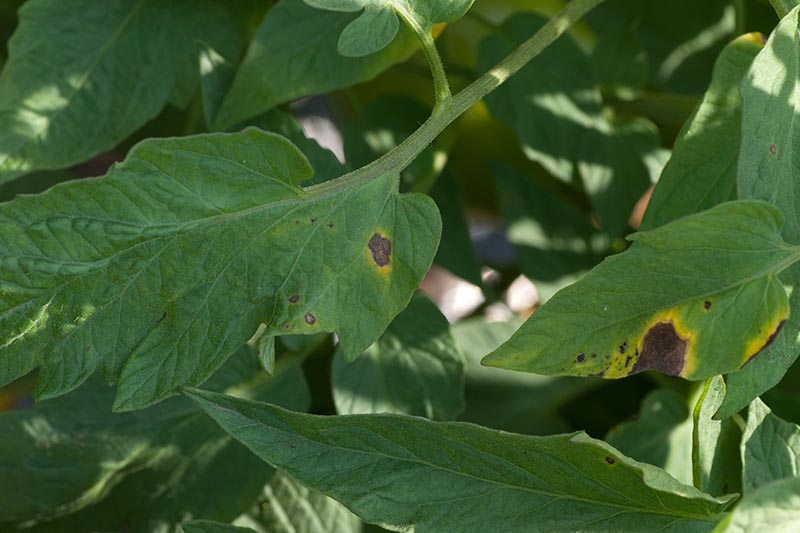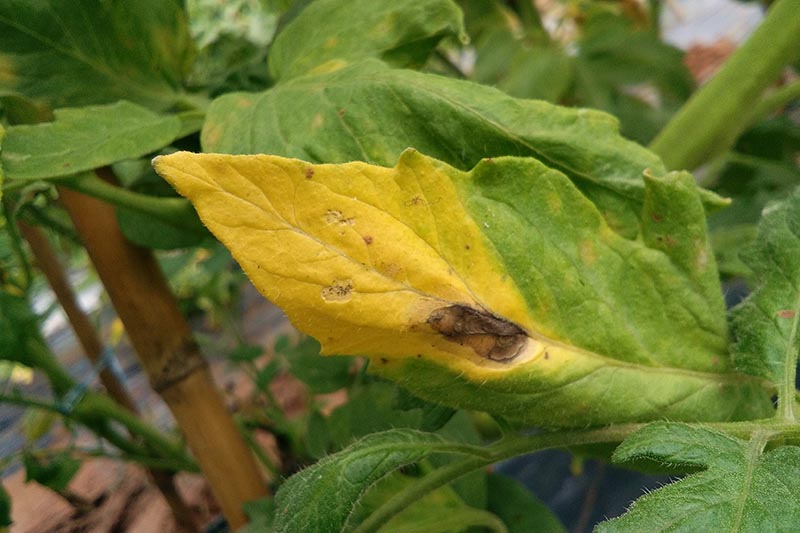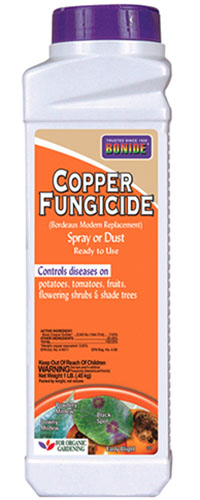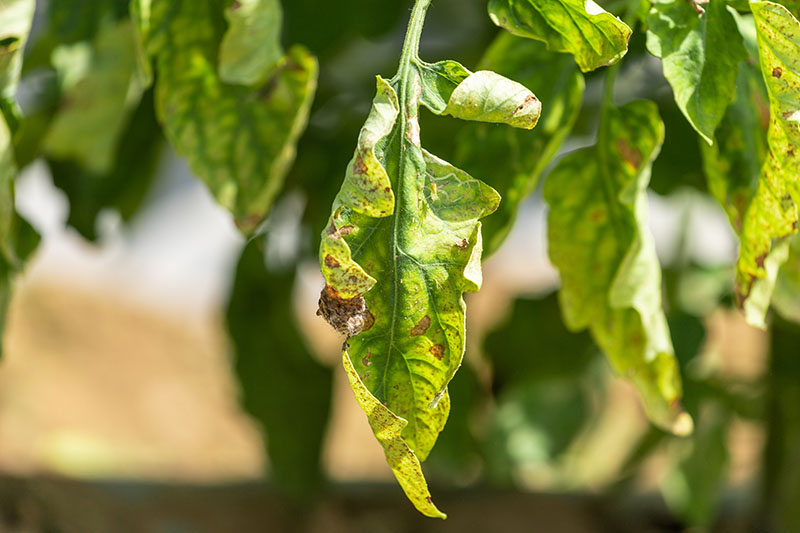This ubiquitous tomato disease does not usually kill the plants, but it can greatly reduce your yield. And even if you grow resistant cultivars, your plants still may not be completely safe. You will have to manage them carefully to keep early blight at bay. However, there are a number of steps you can take to minimize the amount of damage that this disease can cause. We link to vendors to help you find relevant products. If you buy from one of our links, we may earn a commission.
What Is Early Blight?
Early blight is a fungal disease caused by Alternaria solani. It can occur at any time during the growing season. High humidity and temperatures above 75°F cause it to spread rapidly. The fungus overwinters in the soil, and spores can be spread by wind, water, insects, and even on your clothes or shoes. If you catch an outbreak early enough, you may be able to save your crop. The tomatoes are still edible, particularly if the disease is mostly confined to the foliage. You may have also heard of a disease known as late blight. To avoid any potential confusion, I want to stress that early blight is not the same thing as late blight – the devastating disease responsible for the Irish potato famine. Late blight is caused by a fungus-like water mold, Phytophthora infestans. If you think early blight is bad, late blight is much worse. It is generally fatal to both tomatoes and potatoes; it can spread for miles, and it was largely responsible for the death of one million Irish people (although the reasons for that famine were highly political and not just agricultural in nature). You can learn more about various types of blights affecting tomatoes here.
Symptoms
The first sign that your plants are infected with early blight is usually the appearance of dark brown spots on the lower leaves. This disease usually progresses from the bottom of the plant to the top. These are not just any spots. As they grow larger, they form concentric rings that resemble a bull’s-eye, and the rest of the leaf gradually turns yellow. Your plants may lose a lot of their leaves, resulting in sun scald on the fruits. If the stems develop lesions, they will be slightly sunken. As they grow in size, they will develop the same concentric markings that appear on the leaves. If the spots are near the ground, they can girdle the stems and prevent the plant from thriving by limiting the plant’s uptake of water and nutrients.
Both immature and mature fruit can be affected. The infection starts at the stem end and forms a leathery, dark, sunken area with – you guessed it – concentric rings. Even seedlings are vulnerable. They can develop telltale symptoms on their cotyledons, and severely affected seedlings will die.
Disease Cycle
Part of the reason that there is pretty much no escape from this fungus is that it overwinters in the soil and in infected plant debris. It is often introduced into gardens via contaminated seed or transplants. The lower leaves become infected via contaminated soil – either from direct contact or from rain splashing fungal spores onto the plant. Flea beetles sometimes transmit the pathogen as well as they travel from plant to plant. The fungal spores require free water, such as rain or heavy dew, or at least 90% humidity to germinate. They are not very fussy about temperature, and will germinate in a wide range of temperatures, from 47 to 90°F. After the spores have germinated, lesions can form on infected plants in as little as five days. When the spores are present in a garden or field, they can be spread by wind, equipment, insect pests, or human contact.
Resistant Varieties Can Still Become Infected
Many tomato cultivars exhibit some resistance to early blight. However, resistance is not the same thing as immunity. Regardless of the cultivar that you have selected, your plants can still be infected with early blight if you do not take precautions to prevent the disease. Cornell University’s Department of Plant Pathology provides an extensive listing of resistant varieties. Fortunately, even though tomato plants may not be immune to early blight, you can take measures to minimize the chances of infection.
‘Cloudy Day’ Ready to harvest in 70 days, you can find packets of 25 seeds available at Burpee. If you see “EB” listed on tomato seed packets or in catalogs, that stands for “resistant to early blight.” Keep an eye out for this helpful notation when you are searching for resistant varieties.
Cultural Controls
There are a number of steps you can take during the growing season – or even before it begins – to limit the damage that this fungus may do to your plants. These are the most effective ways to prevent it from taking hold in your garden:
Rotate Your Crops
When you harvest a bumper crop one year, it is so tempting to plant in the same spot the following season. However, if tomatoes are the crop in question, restrain yourself! You increase the chance of developing an early blight infection if you grow tomato plants in the same place in consecutive years. Wait at least two years before planting in the same location again, since the spores can persist in the soil and any partially decomposed plants for a year to follow. This is true even if you didn’t see any symptoms of early blight, since the pathogen can start building up without your knowledge. This applies to any crops in the nightshade family as well, such as eggplant, which can also be infected by the fungus.
Purge Nightshades and Volunteer Tomato Plants
Plants in the same family as tomatoes (solanaceous plants, or nightshades), and volunteer tomato plants can also serve as hosts for Alternaria species. These can pass the infection on to your tomato plants. This is true for edible crops such as potatoes, as well as hairy nightshade, black nightshade, and horse nettle, so be vigilant and keep these weeds out of your garden. When you remove the weeds and volunteer plants, make sure you destroy them – do not place on your compost pile.
Keep Your Plants Dry
The Alternaria spores require a lot of moisture to germinate. Tomato plants are used to growing in dry climates, so they are unusually sensitive to water on their leaves, which makes them more prone to fungal infections than many other crops. Take every precaution you can to minimize the amount of moisture on your tomato plants. In the presence of spores, this can help to prevent a fungal infection from getting worse. Try to avoid working with or around your plants in wet weather. Using drip irrigation instead of watering from overhead will help to keep your plants dry.
Stake Your Plants
When your plants are staked, this helps to create better airflow around them, helping them to stay dry.
Another benefit is that there will be less contact between the leaves and the soil that could be contaminated with spores. Pruning the suckers at the bottom of the plant will also help. However, don’t wait until your tomatoes are fully grown to stake them. You should put the stakes in at the time of planting. If you stake them later on, you risk damaging the roots. Learn how to use Florida weave to support your tomato plants.
Remove Infected Plants
If you see signs of early blight on one or two of your plants, it’s best to pull them up and destroy the debris immediately. Do not place it on the compost pile.
Organic Treatments
Even if they aren’t showing any symptoms, if one plant has been infected, then it’s likely that the infection has already spread to your other plants. There are a few treatment options available.
Bonide® Copper Fungicide Dust The first is a modern version of the classic Bordeaux Mixture, Bonide® Copper Fungicide Dust, and it’s available from Arbico Organics. The original Bordeaux mixture contained copper sulfate and lime and could sometimes be toxic to plants. However, this formulation with copper alone is much safer, and is approved for use on edibles. Use either diluted as a spray, or dust the powder onto the foliage, every three days.
CEASE Biological Fungicide Another option is the biofungicide CEASE, available from Arbico Organics. This is a strain of the bacterium Bacillus subtilis that can help prevent the infection from spreading. While the copper fungicide dust will kill existing infections, CEASE decreases the likelihood that any remaining fungi will spread throughout your crop. See our guide to learn more about controlling plant pathogens with Bacillus subtilis.
Fungicides
A variety of fungicides are effective against early blight, but the fungi that cause this infection are becoming resistant in some areas. You need to find a fungicide that acts on multiple targets in the fungus at the same time, so resistance is less likely to develop. In other words, if a fungicide targets one specific aspect of the organism’s metabolism, resistance develops much more quickly than if the chemical targets a number of different biochemical processes at the same time. You may want to apply fungicide as a preventative measure. If so, apply it at fruit set, or just before, and reapply every 7 to 14 days, avoid harvesting your tomatoes within 7 days of application. Always follow the manufacturer’s recommendations when you use chemical treatments.
There Is Hope Against This Ubiquitous Pathogen
Despite its frequent presence on tomatoes, there are steps you can take to minimize the risk of initial infection and subsequent spread of early blight. Some of these are standard protocols for growing tomatoes, like removing all plant debris at the end of the season, and rotating your crops.
Others are more specific to the problem, like using biofungicides or chemical fungicides to treat the infection. Have you had success battling early blight? Let us know how you fared in the comments. And for more information about growing tomatoes in your garden, you’ll need the following guides next:
Blossom-End Rot: What to Do if Your Tomatoes Rot on the Bottom What’s the Difference Between Determinate and Indeterminate Tomatoes? How to Make Tomatoes Turn Red When They Refuse to Ripen on the Vine Cracked Fruit on the Vine: Are Split Tomatoes Safe to Eat?
© Ask the Experts, LLC. ALL RIGHTS RESERVED. See our TOS for more details. Product photos via Arbico Organics and Bonide. Uncredited photos: Shutterstock.
